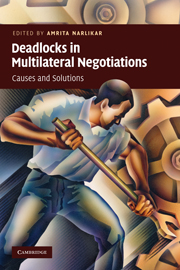Book contents
- Frontmatter
- Contents
- List of figures
- List of tables
- Notes on contributors
- Acknowledgements
- Introduction
- Part I Disciplinary insights
- 1 The politics of deadlocks
- 2 From Bretton Woods to Havana: multilateral deadlocks in historical perspective
- 3 Talking one's way out of strikes
- 4 Litigating the way out of deadlock: the WTO, the EU and the UN
- Part II Case studies
- Conclusion: case studies as evidence: lessons learned
- Bibliography
- Index
4 - Litigating the way out of deadlock: the WTO, the EU and the UN
Published online by Cambridge University Press: 05 June 2012
- Frontmatter
- Contents
- List of figures
- List of tables
- Notes on contributors
- Acknowledgements
- Introduction
- Part I Disciplinary insights
- 1 The politics of deadlocks
- 2 From Bretton Woods to Havana: multilateral deadlocks in historical perspective
- 3 Talking one's way out of strikes
- 4 Litigating the way out of deadlock: the WTO, the EU and the UN
- Part II Case studies
- Conclusion: case studies as evidence: lessons learned
- Bibliography
- Index
Summary
In current public international law, normative regimes generally develop as the result of states' common interests. Various institutions are involved in the interplay of multilateral processes and diplomatic practices, which largely contributes to the development of legal regimes. Among those institutions, dispute settlement bodies play the vital role of interpreting and applying the relevant treaty law, customs and agreements which are the outgrowth of previous negotiations. However, the less-studied opposite might also be true: in some cases, judicial recourse and dispute settlement decisions can be used to influence treaty negotiations. As this chapter demonstrates, states can use a variety of institutions in order to attempt to influence and/or influence the outcome of treaty negotiations. Indeed, the dispute settlement mechanisms, for example in the WTO, help states to influence the negotiation of WTO-based treaties in the same policy areas. Thus, the dispute settlement mechanism and the treaty negotiation function of the same institution can form part of an overall policy of states to advance their treaty negotiation strategies.
Multidisciplinary approaches can be used to monitor the way that states use, or restrain from using, case law arguments in their negotiations. If there is indeed a link between dispute settlement based litigation and ensuing or concurrent negotiations, we should be able to observe it in the dispute settlement cases themselves from facts, from declarations by parties, and from the opinions of the deciders.
- Type
- Chapter
- Information
- Deadlocks in Multilateral NegotiationsCauses and Solutions, pp. 96 - 120Publisher: Cambridge University PressPrint publication year: 2010



